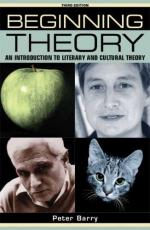
|
| Name: _________________________ | Period: ___________________ |
This quiz consists of 5 multiple choice and 5 short answer questions through New historicism and cultural materialism.
Multiple Choice Questions
1. Who said the following quote found in the chapter titled Theory Before Theory--Liberal Humanism: "We are told that the study of literature 'cultivates the taste, educates the sympathies and enlarges the mind'"?
(a) Elie Wiesel.
(b) Lewis Carroll.
(c) Oscar Wilde.
(d) Edward Freeman.
2. In the chapter titled "Lesbian / Gay Criticism," it states that lesbian and gay literary theory emerged prominently as a distinct field only in the ________.
(a) 1990s.
(b) 2000s.
(c) 1970s.
(d) 1960s.
3. According to the narrator in the Introduction, the term "liberal humanism" became current in what decade?
(a) 1930s.
(b) 1910s.
(c) 1970s.
(d) 1920s.
4. Karl Marx and Friedrich Engels were the join founders of the school of________ according to the Chapter titled "Marxist Criticism."
(a) Reason.
(b) Thought.
(c) Englightenment.
(d) Expectations.
5. Which of the following essays is an example of new historicism in practice written by Louis Montrose?
(a) The Sun Also Rises.
(b) Heart of Darkness.
(c) Lord of the Flies.
(d) A Midsummer Night's Dream.
Short Answer Questions
1. Karl Marx is described by Peter Barry as being a German ________.
2. What term does the narrator explain was a popular term in deconstructive criticism and literally means an impasse?
3. What where the only two universities in England in the nineteenth century?
4. What example did Saussure use to explain what he meant by saying that there are no intrinsic, fixed meanings in language?
5. Who does the narrator describe as a prominent contributor to "Inside/Outside," who pointed out that "identity categories," like "gay" and "straight," "tend to be instruments of regulatory regimes"?
|
This section contains 269 words (approx. 1 page at 300 words per page) |

|




